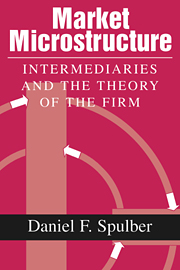Book contents
- Frontmatter
- Contents
- Preface and acknowledgments
- Introduction
- Part I Market microstructure and the intermediation theory of the firm
- Part II Competition and market equilibrium
- Part III Intermediation versus decentralized trade
- Part IV Intermediation under asymmetric information
- Part V Intermediation and transaction-cost theory
- Part VI Intermediation and agency theory
- 11 Agency and the organizational-incentive theory of the firm
- 12 Agency and the intermediation theory of the firm
- Conclusion
- References
- Index
11 - Agency and the organizational-incentive theory of the firm
Published online by Cambridge University Press: 18 December 2009
- Frontmatter
- Contents
- Preface and acknowledgments
- Introduction
- Part I Market microstructure and the intermediation theory of the firm
- Part II Competition and market equilibrium
- Part III Intermediation versus decentralized trade
- Part IV Intermediation under asymmetric information
- Part V Intermediation and transaction-cost theory
- Part VI Intermediation and agency theory
- 11 Agency and the organizational-incentive theory of the firm
- 12 Agency and the intermediation theory of the firm
- Conclusion
- References
- Index
Summary
The organizational-incentive theory of the firm examines delegation and incentives in market contracts and within organizations. Based on economic principal–agent models, the organizational-incentive theory of the firm focuses on the relative costs of adverse selection and moral hazard in market contracts and within organizations. The theory extends the contractual theory of the firm, as discussed in Chapters 9 and 10, which emphasizes the advantages of organization as a means of avoiding market transaction costs.
To understand the organizational-incentive theory of the firm it is useful to begin by asking What is an agent? The question is important not only because of the centrality of principal–agent models in microeconomics. It is fundamental to how economic models characterize market contracts and organizational relationships.
Because the notion of agency comes from law, it is worthwhile noting its legal implications. Agency in law is a fiduciary relationship, that is, one founded on trust. Black's Law Dictionary describes an agent as
One who deals not only with things, as does a servant, but with persons, using his own discretion as to means, and frequently establishing contractual relations between his principal and third persons.
An agent, therefore, can be either one of the following:
A producer
A intermediary.
A producer deals with things, devoting effort to completing tasks. An intermediary deals with other people, establishing contractual relationships.
The traditional economic analysis of the principal–agent problem has tended to emphasize the master–servant relationship, that is, treating the agent as producer.
- Type
- Chapter
- Information
- Market MicrostructureIntermediaries and the Theory of the Firm, pp. 289 - 318Publisher: Cambridge University PressPrint publication year: 1999



